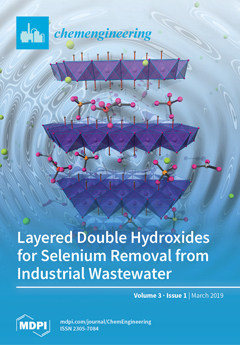This work presents a new insight into the potential of a Ni/CeZrO
2 catalyst in two separate processes: (i) Chemical Vapor Deposition (CVD) using methane as a feedstock to obtain carbon nanotubes (CNTs) and H
2, and (ii) catalyst regeneration with H
[...] Read more.
This work presents a new insight into the potential of a Ni/CeZrO
2 catalyst in two separate processes: (i) Chemical Vapor Deposition (CVD) using methane as a feedstock to obtain carbon nanotubes (CNTs) and H
2, and (ii) catalyst regeneration with H
2O that yields H
2. The direct reaction of methane with H
2O (steam methane reforming (SMR)) leads to H
2 and CO (and CO
2), whereas carbon deposition—regardless of its type—is an unwanted reaction. The concept presented in this work assumes dividing that process into two reactors, which allows one to obtain two valuable products, i.e., CNTs and H
2. The literature data on CNT production via CVD ignores the issue of H
2 formation. Moreover, there is no data concerning CNT production in fluidized bed reactors over ceria-zirconia supported metal catalysts. The results presented in this work show that CNTs can be formed on Ni/CeZrO
2 during CH
4 decomposition, and that the catalyst can be easily regenerated with H
2O, which is accompanied by a high production of H
2. The ability of Ni/CeZrO2 to be regenerated is its main advantage over the Ni-MgO catalyst that is popular for CNT production. This paper also shows that the Ni/CeZrO
2 catalyst has the potential to be used for CNT and H
2 production in a larger scale process, e.g., in a fluidized bed reactor.
Full article





